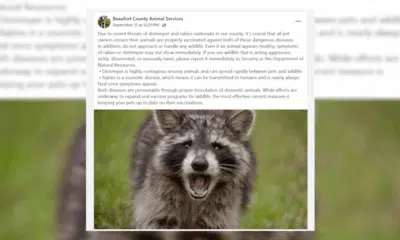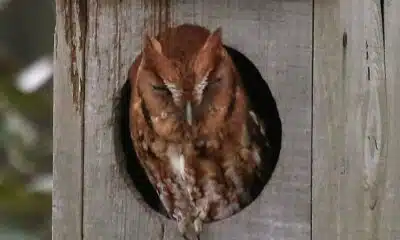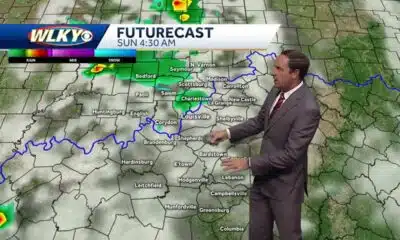News from the South - North Carolina News Feed
Top climate scientist’s departure is sign of ‘brain drain’ at NOAA hub in Asheville – and of deep cuts to research across the country
Climate scientist David Easterling decided it was time to seriously think about retirement from the National Centers for Environmental Information after President Donald Trump took office in January.
There was the immediate withdrawal of the United States from the international Paris Agreement, which was signed by 196 countries in 2015 to limit greenhouse emissions. There were the mass layoffs of federal employees, the moves to increase production of fossil fuels and to cut investment into renewables.
Easterling, the centers’ chief of scientific services – and, peers say, one of the nation’s top climate-change researchers – first set his departure date for November.
He moved it up to April 30 after he was offered a small retirement bonus and learned he was on a list of centers’ staffers eligible for reclassification as political employees.
That would mean he could be fired without cause, which he almost certainly would have been, he said, “because I was leading a group that was looking at climate change.”
Easterling, 69, said he is one of 58 employees who have retired or resigned under similar circumstances from the NCEI – about one third of the workforce at the Asheville headquarters and smaller installations in Maryland, Colorado and Mississippi.

“It’s been a brain drain for them, for sure,” said Ken Kunkel, principal research scholar with the North Carolina Institute for Climate Studies at North Carolina State University.
Though important work will continue at the centers – the largest repository of climate information in the world – its once-central role in addressing climate change has been all but eliminated, Easterling said.
It’s part of a bigger picture revealed in actions that have only accelerated since he decided to retire, he said, including the slashing of research at the Environmental Protection Agency, the 40 percent budget cut at the National Institutes of Health, the loss of billions of dollars worth of research grants for colleges and universities.
The Trump administration has touted such reductions as improving government efficiency. And U.S. Rep. Chuck Edwards, R-Hendersonville, has said the same about the recently passed “One Big Beautiful Bill,” which could further cut research funding. His July 4 statement also praised the law’s tax reductions and deregulation measures. He did not respond to requests for further comment from Asheville Watchdog.
But any benefits of cuts in research will be far outweighed by long-term losses, Easterling said, citing federally backed advancements such as the creation of the internet and the mapping of the human genome that have shaped the modern world and fueled the American economy.
“All these different innovations. That’s what made America great, and it’s still great … It’s never not been great, but it’s starting to fade,” he said. “We’re losing our scientific edge.”
Tracking the “everything issue”
If the dismissive treatment of his colleagues and him is far from the whole story, it’s a significant part of it, Easterling and other climate scientists said.
For the past 12 years, he has led the task force that provided the statistical backbone for the National Climate Assessment, the nation’s most comprehensive, authoritative and widely used climate report.
The assessments were mandated by a 1990 federal law and have been regularly updated since 2000.
The latest version, the 1,834-page Fifth National Climate Assessment published in 2023, contained both the latest climate data and the most advanced projections about future trends. It detailed the consequences of warming and strategies to contain them in a wide range of environmental and economic sectors, in every section of the country.
The document “clearly illustrates how climate change is not only an environmental or a scientific issue, but an everything issue,” Katharine Hayhoe, chief scientist at the Nature Conservancy and one of the assessment’s authors, said at the time of its publication.

A major source of the report’s authority, said Kunkel, the lead scientist on Easterling’s task force, is the consensus it represents.
The report is the “synthesized work of hundreds of authors who have sifted through the evidence,” he said. “Scientists agree that the climate will change if we continue to increase greenhouse gasses in the atmosphere. There’s essentially 100 percent certainty on that.”
Easterling’s responsibilities included verifying the soundness of the science used in the last three assessments, Kunkel said.
And as evidence of Easterling’s contributions to this base of knowledge, he is named 110 times in the 5th assessment, including dozens of citations for research published independently of his work on the report.
To explain the usefulness of the document, he cited the example of farmers who want to know if they need to expand irrigation systems to address the impact of extended droughts. That information is in the report, Easterling said.
Should landowners in the North Carolina mountains invest in growing heat-sensitive Fraser firs as Christmas trees? The assessment can give them the answer.
It could be employed by city leaders in Atlanta to know if they need to build more emergency cooling centers for extreme heatwaves, he said.
And it has been used by the city of Charleston, South Carolina, to guide investment of tens of millions of dollars to upgrade its ancient storm sewer system to handle sea levels that have already risen by about a foot over historic levels.
“That’s just a great example of what climate change is going to end up costing,” Easterling said.
His team also played a big part in spreading the assessment’s message, creating graphics and translating scientific language into lay terms to make the report as accessible as possible.
That access has been undermined by the National Oceanic and Atmospheric Administration (NOAA), which runs the NCEI and did not respond to repeated requests from Asheville Watchdog for comment or to address the number of departures that Easterling documented. This mirrors a figure previously reported by the Asheville Citizen-Times.
The 2023 assessment and all earlier versions have been removed from NOAA’s website and work on the next update, due to be completed in 2028, has come to a standstill. The agency has also told hundreds of scientists volunteering their time to create this report that their services are no longer needed.
Among other examples of declining access to information – the agency recently announced it has stopped updating the webpage showing the increased frequency of “billion dollar disasters,” events that have created at least that inflation-adjusted amount of damage.
This trend reflects the growing severity of storms and the growing value of development in disaster-prone areas, Easterling said, and the NCEI scientist responsible for this webpage is among those who have recently departed.
Easterling is more concerned about what such cutbacks mean for science than his own life.
He is continuing to research and write scientific papers, he said. He will probably do some consulting. He has volunteered his services – and the extensive knowledge he has developed researching extreme precipitation – to one NOAA effort that is still moving forward, updating a massive rainfall database.
His retirement has also allowed him to spend more time with his wife, Kimberly, their two adult daughters and their four grandchildren, he said during an interview last week, overlooking dense forest from the back porch of his Henderson County home.
But he would have liked to have stuck to his original plan, which was to keep working for maybe two more years, until he was sure the next assessment was well on its way to completion.
“I liked what I was doing,” he said. “I felt like I was doing some good for society and wanted to keep going.”
Asheville Watchdog welcomes thoughtful reader comments on this story, which has been republished on our Facebook page. Please submit your comments there.
Asheville Watchdog is a nonprofit news team producing stories that matter to Asheville and Buncombe County. Dan DeWitt is The Watchdog’s deputy managing editor/senior reporter. Email: ddewitt@avlwatchdog.org. The Watchdog’s local reporting is made possible by donations from the community. To show your support for this vital public service go to avlwatchdog.org/support-our-publication/.
Related
The post Top climate scientist’s departure is sign of ‘brain drain’ at NOAA hub in Asheville – and of deep cuts to research across the country appeared first on avlwatchdog.org
Note: The following A.I. based commentary is not part of the original article, reproduced above, but is offered in the hopes that it will promote greater media literacy and critical thinking, by making any potential bias more visible to the reader –Staff Editor.
Political Bias Rating: Center-Left
The article presents a critical perspective on the Trump administration’s handling of climate science and federal research funding, emphasizing concerns about scientific workforce reductions, budget cuts, and diminished climate initiatives. The language highlights negative consequences of policy changes and underscores the importance of climate science, suggesting a bias toward prioritizing environmental protection and scientific integrity. However, the piece also includes statements from a Republican lawmaker and factual reporting on government actions, maintaining some balance. Overall, the framing and tone lean toward a center-left viewpoint that supports climate action and critiques deregulation and funding cuts.
News from the South - North Carolina News Feed
White House officials hold prayer vigil for Charlie Kirk
SUMMARY: Republican lawmakers, conservative leaders, and Trump administration officials held a prayer vigil and memorial at the Kennedy Center honoring slain activist Charlie Kirk, founder of Turning Point USA. Kirk was killed in Utah, where memorials continue at Utah Valley University and Turning Point USA’s headquarters. Police say 22-year-old Tyler Robinson turned himself in but has not confessed or cooperated. Robinson’s roommate, his boyfriend who is transitioning, is cooperating with authorities. Investigators are examining messages Robinson allegedly sent on Discord joking about the shooting. Robinson faces charges including aggravated murder, obstruction of justice, and felony firearm discharge.
White House officials and Republican lawmakers gathered at the Kennedy Center at 6 p.m. to hold a prayer vigil in remembrance of conservative activist Charlie Kirk.
https://abc11.com/us-world/
Download: https://abc11.com/apps/
Like us on Facebook: https://www.facebook.com/ABC11/
Instagram: https://www.instagram.com/abc11_wtvd/
Threads: https://www.threads.net/@abc11_wtvd
TIKTOK: https://www.tiktok.com/@abc11_eyewitnessnews
News from the South - North Carolina News Feed
Family, friends hold candlelight vigil in honor of Giovanni Pelletier
SUMMARY: Family and friends held a candlelight vigil in Apex to honor Giovanni Pelletier, a Fuquay Varina High School graduate whose body was found last month in a Florida retention pond. Giovanni went missing while visiting family, after reportedly acting erratically and leaving his cousins’ car. Loved ones remembered his infectious smile, laughter, and loyal friendship, expressing how deeply he impacted their lives. His mother shared the family’s ongoing grief and search for answers as authorities continue investigating his death. Despite the sadness, the community’s support has provided comfort. A celebration of life mass is planned in Apex to further commemorate Giovanni’s memory.
“It’s good to know how loved someone is in their community.”
More: https://abc11.com/post/giovanni-pelletier-family-friends-hold-candlelight-vigil-honor-wake-teen-found-dead-florida/17811995/
Download: https://abc11.com/apps/
Like us on Facebook: https://www.facebook.com/ABC11/
Instagram: https://www.instagram.com/abc11_wtvd/
Threads: https://www.threads.net/@abc11_wtvd
TIKTOK: https://www.tiktok.com/@abc11_eyewitnessnews
News from the South - North Carolina News Feed
NC Courage wins 2-1 against Angel City FC
SUMMARY: The North Carolina Courage defeated Angel City FC 2-1 in Cary, ending their unbeaten streak. Monaca scored early at the 6th minute, followed by Bull City native Brianna Pinto’s goal at the 18th minute, securing a 2-0 halftime lead. Angel City intensified in the second half, scoring in the 88th minute, but the Courage held firm defensively to claim victory. Pinto expressed pride in the win, emphasizing the team’s unity and playoff ambitions. Nearly 8,000 fans attended. Coverage continues tonight at 11, alongside college football updates, including the Tar Heels vs. Richmond game live from Chapel Hill.
Saturday’s win was crucial for the Courage as the regular season starts to wind down.
https://abc11.com/post/north-carolina-courage-wins-2-1-angel-city-fc/17810234/
Download: https://abc11.com/apps/
Like us on Facebook: https://www.facebook.com/ABC11/
Instagram: https://www.instagram.com/abc11_wtvd/
Threads: https://www.threads.net/@abc11_wtvd
TIKTOK: https://www.tiktok.com/@abc11_eyewitnessnews
-
Our Mississippi Home6 days ago
Screech Owls – Small but Cute
-
News from the South - Arkansas News Feed7 days ago
NW Arkansas Championship expected to bring money to Rogers
-
News from the South - Tennessee News Feed7 days ago
What to know about Trump’s National Guard deployment to Memphis
-
Local News6 days ago
New findings by NASA Mars rover provide strongest hints yet of potential signs of ancient life
-
The Center Square5 days ago
What are data centers and why do they matter? | National
-
Our Mississippi Home5 days ago
Rolling Through History: The Comfort and Culture of Dumplings
-
News from the South - North Carolina News Feed7 days ago
Is nail gel actually harmful? It's complicated
-
News from the South - Kentucky News Feed7 days ago
Few showers possible Saturday night into Sunday















































